View in other NatureServe Network Field Guides
NatureServe
Montana
Utah
Wyoming
Idaho
Wisconsin
British Columbia
South Carolina
Yukon
California
New York
Kerry's Paintbrush - Castilleja kerryana
State Rank Reason (see State Rank above)
Castilleja kerryana is a recently recognized species that grows in alpine habitat in a portion of the Scapegoat Wilderness in Montana. Populations tend to be small and scattered on slopes and ridges, and apparently absent on broad, fairly flat alpine terrain. Although Castilleja species in general have brittle stems that are easily damaged by livestock, grazing is not known to occur where Kerry's Paintbrush grows. The plant appears to be limited geographically in Montana, and additional surveys are needed to accurately determine its range.
- Details on Status Ranking and Review
Range Extent
ScoreA - <100 sq km (< ~40 sq mi)
Area of Occupancy
ScoreD - 6-25 4-km2 grid cells
Number of Populations
ScoreB - 6 - 20
Number of Occurrences or Percent Area with Good Viability / Ecological Integrity
ScoreC - Few (4-12) occurrences with excellent or good viability or ecological integrity
Environmental Specificity
ScoreB - Narrow. Specialist or community with key requirements common
Threats
ScoreD - Low
CommentThreat categories include: Climate change & severe weather and Droughts. Heat waves are a potential threat.
General Description
Perennial. Stems decumbent proximally, ascending-erect distally. Herbage conspicuously villous with a mixture of shorter stipitate-glandular hairs and longer non-glandular hairs. Leaves relatively few, 7-10 cm long, linear to narrowly lanceloate, distally acute-tipped, sometimes becoming 3-5-lobed below the inflorescence. Inflorescence long hairy and shortly stipitate-glandular; bracts mostly reddish but also various shades of salmon, pink, and violet (or infrequently yellowish). Flowers: calyx (23-)25-34(-37) mm long, primary clefts subequal on abaxial and adaxial sides, the lobes distally emarginate or more frequently shallowly cleft into two segments 1-3 mm long; corolla (25-)28-45(-50) mm long, galea (upper lip of corolla) 8-14 mm long, lower lip 4-9 mm long (Egger, Phytoneuron 2013-21: 1-14).
Diagnostic Characteristics
In Montana Castilleja kerryana most closely resembles C. pulchella; however, the latter has mostly included, shorter corollas (only 17-22 mm long), corolla beaks less than twice the length of the lower lip, and a pale yellowish (or less commonly purplish) inflorescence coloration (Egger, Phytoneuron 2013-21:1-14).
Mark Egger named this plant after his daughter, Kerry.
Species Range
Montana Range
Range Descriptions
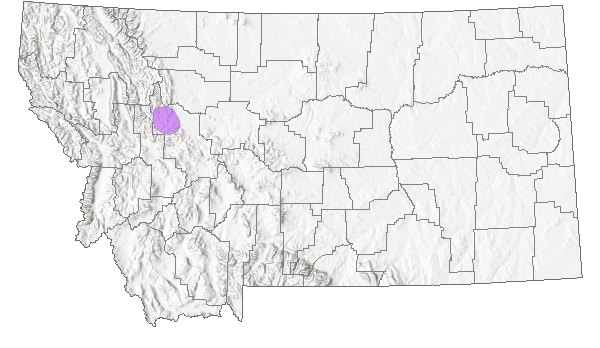
 Native
Native
Range Comments
Montana edemic, restricted to the Scapegoat Plateau in the Straight Creek and South Fork of the Sun River watersheds, each a tributary of the Sun River (Egger 2013, Phytoneuron 2013-21: 1-14).
Observations in Montana Natural Heritage Program Database
Number of Observations: 46
(Click on the following maps and charts to see full sized version)
Map Help and Descriptions
Relative Density
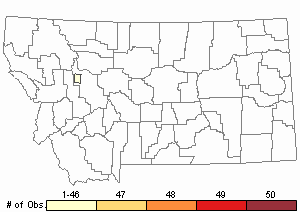
Recency
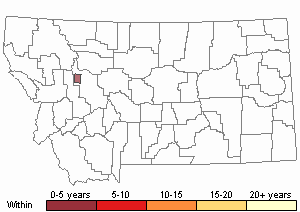
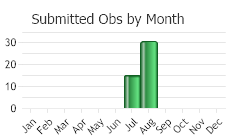
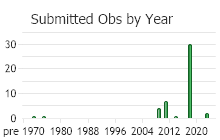
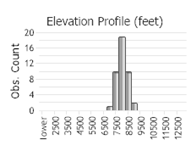 (Observations spanning multiple months or years are excluded from time charts)
(Observations spanning multiple months or years are excluded from time charts)
Habitat
Rocky or gravelly limestone substrates of Cambrian origin; slopes and ridges from upper subalpine krummholz or turf communities in upper alpine fell fields (Egger, Phytoneuron 2013-21: 1-14).
Ecology
POLLINATORS The following animal species have been reported as pollinators of this plant species or its genus where their geographic ranges overlap:
Bombus appositus,
Bombus bifarius,
Bombus fervidus,
Bombus flavifrons,
Bombus melanopygus,
Bombus sylvicola,
Bombus occidentalis, and
Bombus kirbiellus (Macior 1974, Thorp et al. 1983, Bauer 1983, Mayer et al. 2000, Wilson et al. 2010, Pyke et al. 2012, Koch et al. 2012, Miller-Struttmann and Galen 2014, Williams et al. 2014).
Stewardship Responsibility
Threats or Limiting Factors
STATE THREAT SCORE REASON
Reported threats to Montana’s populations of Kerry’s Paintbrush are currently assigned as unknown. Reports of impacts driven by climate change is recognized, and the concern is amplified for Kerry’s Paintbrush because it occurs on porous substrates (MTNHP Threat Assessment 2021). However, climate-related impacts occur over a time period exceeding 10 years, and the time frame limits of response necessary for threat ranking methods. Expected impacts to Kerry’s Paintbrush plants or populations due to climate-related habitat shifting or alteration in a 10-year time frame are needed to assess its relative risk to the state populations.
References
- Literature Cited AboveLegend:
 View Online Publication
View Online Publication Bauer, P.J. 1983. Bumblebee pollination relationships on the Beartooth Plateau tundra of Southern Montana. American Journal of Botany. 70(1): 134-144.
Bauer, P.J. 1983. Bumblebee pollination relationships on the Beartooth Plateau tundra of Southern Montana. American Journal of Botany. 70(1): 134-144. Egger, J.M. 2013. Castilleja kerryana (Orobanchaceae): a new species from the Rocky Mountains of northern Montana. Phytoneuron 2013-21: 1-14.
Egger, J.M. 2013. Castilleja kerryana (Orobanchaceae): a new species from the Rocky Mountains of northern Montana. Phytoneuron 2013-21: 1-14. Koch, J., J. Strange, and P. Williams. 2012. Bumble bees of the western United States. Washington, DC: USDA Forest Service, Pollinator Partnership. 143 p.
Koch, J., J. Strange, and P. Williams. 2012. Bumble bees of the western United States. Washington, DC: USDA Forest Service, Pollinator Partnership. 143 p. Macior, L.M. 1974. Pollination ecology of the Front Range of the Colorado Rocky Mountains. Melanderia 15: 1-59.
Macior, L.M. 1974. Pollination ecology of the Front Range of the Colorado Rocky Mountains. Melanderia 15: 1-59. Mayer, D.F., E.R. Miliczky, B.F. Finnigan, and C.A. Johnson. 2000. The bee fauna (Hymenoptera: Apoidea) of southeastern Washington. Journal of the Entomological Society of British Columbia 97: 25-31.
Mayer, D.F., E.R. Miliczky, B.F. Finnigan, and C.A. Johnson. 2000. The bee fauna (Hymenoptera: Apoidea) of southeastern Washington. Journal of the Entomological Society of British Columbia 97: 25-31. Miller-Struttmann, N.E. and C. Galen. 2014. High-altitude multi-taskers: bumble bee food plant use broadens along an altitudinal productivity gradient. Oecologia 176:1033-1045.
Miller-Struttmann, N.E. and C. Galen. 2014. High-altitude multi-taskers: bumble bee food plant use broadens along an altitudinal productivity gradient. Oecologia 176:1033-1045. MTNHP Threat Assessment. 2021. State Threat Score Assignment and Assessment of Reported Threats from 2006 to 2021 for State-listed Vascular Plants. Botany Program, Montana Natural Heritage Program, Helena, Montana.
MTNHP Threat Assessment. 2021. State Threat Score Assignment and Assessment of Reported Threats from 2006 to 2021 for State-listed Vascular Plants. Botany Program, Montana Natural Heritage Program, Helena, Montana. Pyke, G.H., D.W. Inouye, and J.D. Thomson. 2012. Local geographic distributions of bumble bees near Crested Butte, Colorado: competition and community structure revisited. Environmental Entomology 41(6): 1332-1349.
Pyke, G.H., D.W. Inouye, and J.D. Thomson. 2012. Local geographic distributions of bumble bees near Crested Butte, Colorado: competition and community structure revisited. Environmental Entomology 41(6): 1332-1349. Thorp, R.W., D.S. Horning, and L.L. Dunning. 1983. Bumble bees and cuckoo bumble bees of California (Hymenoptera: Apidae). Bulletin of the California Insect Survey 23:1-79.
Thorp, R.W., D.S. Horning, and L.L. Dunning. 1983. Bumble bees and cuckoo bumble bees of California (Hymenoptera: Apidae). Bulletin of the California Insect Survey 23:1-79. Williams, P., R. Thorp, L. Richardson, and S. Colla. 2014. Bumble Bees of North America. Princeton, NJ: Princeton University Press. 208 p.
Williams, P., R. Thorp, L. Richardson, and S. Colla. 2014. Bumble Bees of North America. Princeton, NJ: Princeton University Press. 208 p. Wilson, J.S., L.E. Wilson, L.D. Loftis, and T. Griswold. 2010. The montane bee fauna of north central Washington, USA, with floral associations. Western North American Naturalist 70(2): 198-207.
Wilson, J.S., L.E. Wilson, L.D. Loftis, and T. Griswold. 2010. The montane bee fauna of north central Washington, USA, with floral associations. Western North American Naturalist 70(2): 198-207.
- Web Search Engines for Articles on "Kerry's Paintbrush"





